
Guests
- Duane Bradleystation manager of Pacifica Radio station KPFT.
- Mary Thomasprogrammer on KPFT.
A bullet pierces the studio window of Pacifica Radio station KPFT. It’s not the first time the Houston station has been targeted. KPFT is the only radio in the country whose transmitter was blown up twice–shortly after it went on the air in 1970–by the Ku Klux Klan. [includes rush transcript]
Transcript
AMY GOODMAN: A drive-by shooting targeted Pacifica Radio station KPFT in Houston early Monday morning. A single bullet blasted through a Plexiglas window into the station’s studio at 1:00 a.m. No one was injured in the shooting, but the bullet came within 18 inches of Mary Thomas. She was hosting a Zydeco music program at the time.
KPFT’s station manager Duane Bradley said the shooting might have been political. If so, it would not be the first politically motivated attack on KPFT. More than 35 years ago, the Ku Klux Klan blew up the station’s transmitters twice within the Houston station’s first year of operation. In October of 1970, five months after the first bombing, KPFT’s transmitter was bombed for a second time, just as the station was broadcasting folk legend Arlo Guthrie’s song “Alice’s Restaurant.”
This is a clip of a recreation of that moment.
ARLO GUTHRIE: [singing] I wanted to feel like the all-American kid. I walked in, I was hung down, brung down, swung down, hung up. I walked in and sat down. They gave me a piece of paper, said, “Kid, see the psychiatrist, room 604.” I walked up there. I said, “Shrink, I want to kill. I mean, I mean, I wanna” —
[explosion]
UNIDENTIFIED WOMAN: Well, when I first heard that Pacifica had been bombed off the air, it was like shock. I couldn’t imagine that anybody would want to really, you know, do something like that.
UNIDENTIFIED MAN: It was a very professional job. They knew what to do. They knew where to find you. And they did it.
AMY GOODMAN: An excerpt of a recreation of what happened in 1970 when KPFT first went on the air, the only radio station in the country to be blown up — in fact, blown up twice by the Klan.
Well, we’re now joined from Houston, Texas by KPFT station manager Duane Bradley. We’re also joined by Mary Thomas. She is the host of the weekly Zydeco music program on KPFT. The bullet that was fired into the station Monday morning narrowly missed her head. We welcome you both to Democracy Now!
Mary, let’s begin with you. Explain exactly what was happening. It was 1:00 on Monday morning?
MARY THOMAS: Yes.
AMY GOODMAN: And where were you in the station?
MARY THOMAS: I was at the board doing the music.
AMY GOODMAN: And then what happened?
MARY THOMAS: Well, somebody — I could see somebody from the inside camera knocking on the door. So John, our — the person that was helping me, he went to the door to see who it was. And I told him — I said, “If you don’t know who it is, don’t let him in.” But anyway, when he got to the door, he found out that it was somebody that we knew that comes to the station. And while he was doing this, then a big boom came through the window right where I had just moved my chair from that window. And I fell to the floor, because I turned my head right quick, but then I saw the big hole, and I just fell to the floor and crawled into the next room in the next room and made a phone call to 911.
AMY GOODMAN: Duane Bradley, you’re the station manager. Can you talk about what you’ve pieced together at this point?
DUANE BRADLEY: Well, we’ve had the Houston Police Department out. They were there within twenty minutes. And, of course, they conducted an initial investigation, and they were unable to turn up any slug or fragments from whatever round was fired into the building. They’re in the middle of conducting an investigation still, of course. Around daylight, our chief engineer was out looking around the edge of the property and out where John had pointed to where he had seen the shot fired from the vehicle moving by. Steve Brightwell, our chief engineer, found a shell casing, so we called HPD back out to the scene, didn’t touch the evidence.
AMY GOODMAN: Wait a second. Duane, you said — so the police didn’t find the shell casing, but you did, when it got lighter.
DUANE BRADLEY: Right, yeah. KPFT chief engineer Steve Brightwell found it. We called the police back out, and they took it into evidence. And we’ve been able to find out that this is a 39-millimeter round that’s commonly used in AK-47 assault rifles. So this has kind of ramped up the fear factor, if you will. It’s certainly not somebody just driving by in the middle of the night with a BB gun.
AMY GOODMAN: So what’s your sense of what happened? And did John or who was at the door, Mary’s co-producer on the Zydeco show, see any car, see any person?
DUANE BRADLEY: John noticed that there was a slow-moving vehicle that had gone by earlier. And as he was letting these two folks into the building about 12 feet away from the control room window where the front door was, he noticed this car going by. And he remarked to me later that it was moving slower than you would go through a school zone. He estimated about 15 miles an hour maybe. And when it got to the eastern edge of our property is when this shot rang out. The two folks at the door thought it was a backfire, but John knew that it was a gunshot, and so he pulled them into the building real quick and got them behind one of the outer walls, as Mary was crawling from the control room into the on-air studio.
AMY GOODMAN: Duane, do you think this could be politically motivated?
DUANE BRADLEY: Well, certainly we can’t say it’s not. There’s nothing that’s been found yet in terms of who may have done this. KPFT has been, as you pointed out, at a point of controversy in Houston since day one, 37-and-a-half years ago. There were no overt threats to the station. We’ve received no email or voicemail or letters or anything. No one has claimed responsibility for it, but we do on Sunday evenings, prior to Mary’s Zydeco Pas Sale show at midnight, from about 6:00 ’til midnight we have some relatively, you know, controversial programming, Afrocentric programming, that can sometimes be quite heated. And certainly we know from past experience that KPFT has been threatened and indeed attacked.
AMY GOODMAN: I want to play a longer clip of what happened in October — October 12, 1970 — the second time the transmitter of KPFT was blown up. The clip also includes commentary from KPFT founder Larry Lee.
LARRY LEE: 11:00 Central time last night, Arlo Guthrie was on record singing “Alice’s Restaurant.” Just as he reached the part where he was shouting “Kill, kill the Army psychiatrist,” our transmitter got killed, blown up by what now appears to be 15 sticks of dynamite.
KPFT DJ: This is KPFT in Houston, Pacifica Radio. Now, one of my favorite songs, “Alice’s Restaurant” by Arlo Guthrie.
ARLO GUTHRIE: [singing] They got a building down in New York City called White Hall Street, where you walk in, get injected, inspected, detected, infected, neglected and selected. I went in there one morning to have my physical examination. I got good and drunk the night before. I wanted to — I wanted to be the all-American —- I mean, I wanted to feel like the all-American kid. I walked in, I was hung down, brung down, swung down, hung up. I walked in and sat down. They gave me a piece of paper, said, “Kid, see the psychiatrist, room 604.” I walked up there. I said, “Shrink, I want to kill.” -—
[explosion]
REPORTER: How did you determine that that —- or how did anybody determine that’s what was -—?
LARRY LEE: That’s the estimate made by the Houston arson squad, which worked the case today with the Harris County Sheriff’s Department, the bomb squad and the FBI, which dropped out of this case this afternoon for lack of jurisdiction. Curiously enough, the FCC says that we’re probably the first radio station in the country to be dynamited off the air, and there’s no federal law that covers such a thing.
REPORTER: I see. I thought it was a federal law to —
LARRY LEE: We all assumed that it was, but they checked the books today and found out that it wasn’t. I assume one will now be written.
REPORTER: I understand there were no injuries in the explosion, is that right?
LARRY LEE: No, but it was close. Sam Diaz, the volunteer who makes the required daily logging of the meters out at the transmitter is very punctual. He shows up every night at 11:00. Last night he was 20 minutes late, fortunately for him, found the smoking rubble of the transmitter, which is located 20 miles south of downtown Houston, where the studios are. If he had been on time, he might have gone up with it.
The dynamite, or whatever it was, was very professionally planted, because while it smashed our transmitter and its shack to smithereens, two nearby shacks and their related transmitters escaped unscathed, as did the transmission tower itself. This morning, a local construction company donated planning materials and labor to build a highly secure underground bomb-proof bunker to put the next transmitter in.
AMY GOODMAN: And that was an excerpt of the radio broadcast just after the station’s transmitter was blown up, dynamite strapped to the base of the transmitter. This was October 1970.
Duane Bradley, Larry Lee talked about — that was the KPFT general manager then — the FBI saying they wouldn’t be involved. Is the FBI — why weren’t they be involved then? And will they be involved in this investigation today?
DUANE BRADLEY: It’s strange to hear that historic record and know that though we are a federally licensed facility, that the FBI didn’t get involved at that point, because they didn’t believe they had any cause to or any legal standing to.
I’ve been in touch with our attorneys in Washington, D.C., and we’re working through the enforcement bureau at the FCC. We spoke with them yesterday to have the folks in Washington approach the FBI about getting involved here in Houston. There are no staff members on the Houston FBI office who, I’m told, have the expertise to deal with the kind of investigation that would be needed to really get to the bottom of what happened here. So we’re kind of pushing on them a little bit through our attorney in Washington.
AMY GOODMAN: You’re holding a news conference today?
DUANE BRADLEY: Yes. We’ll be holding a news conference outside the station studio window this afternoon at 1:00 p.m. And we’ll be visiting with our city councilmember, Ada Edwards, who represents the district that KPFT is located in. Our congressional representative, Sheila Jackson-Lee, is out of the country but will be sending a statement that I’ll be reading on her behalf.
AMY GOODMAN: And, Mary Thomas, will you also be speaking?
MARY THOMAS: I’ll do my best.
AMY GOODMAN: Is this going to change how you do your Zydeco program now?
MARY THOMAS: A little, yes.
AMY GOODMAN: Do you feel safe?
MARY THOMAS: Oh, I’m OK, yeah. I’m OK, yes.
AMY GOODMAN: And, Duane, all of the producers that do their programs around the clock, how will they now, as this investigation goes on, be protected? You’re in the Montrose section of Houston, not a place where there are a lot of drive-by shootings?
DUANE BRADLEY: Well, it’s a bohemian section near downtown Houston, and it’s not completely unusual that there would be the sound of a weapon fired, though it is rather rare. And we definitely are taking all of our volunteer and paid staff producers’ safety at the highest level of concern. And we’re looking at all of our different options right now as to whether or not we ought to just brick over that whole front of the building or put up steel plating or just replace the bulletproof glass with something a bit more stout.
AMY GOODMAN: Well, I want to thank you both for being with us, Duane Bradley, station manager of Pacifica station KPFT, and Mary Thomas, host of the Zydeco program on KPFT. She narrowly missed the bullet that shot through what they thought was bulletproof glass in the front of the station.

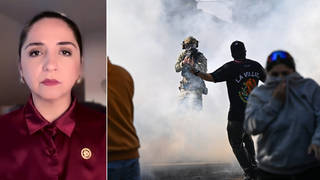
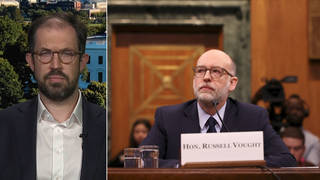
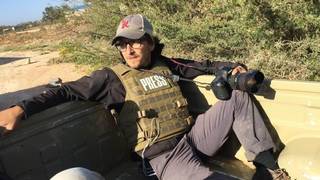
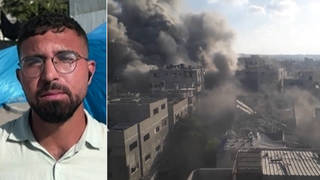





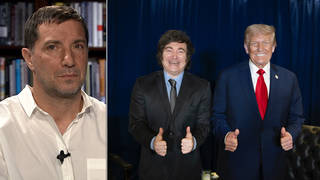
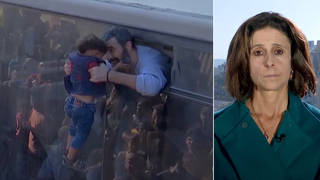
Media Options